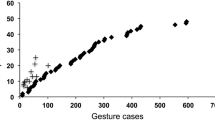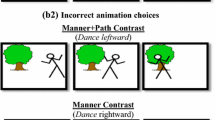Abstract
This study compares words and gestures produced in a controlled experimental setting by children raised in different linguistic/cultural environments to examine the robustness of gesture use at an early stage of lexical development. Twenty-two Italian and twenty-two Japanese toddlers (age range 25–37 months) performed the same picture-naming task. Italians produced more spoken correct labels than Japanese but a similar amount of representational gestures temporally matched with words. However, Japanese gestures reproduced more closely the action represented in the picture. Results confirm that gestures are linked to motor actions similarly for all children, suggesting a common developmental stage, only minimally influenced by culture.



Similar content being viewed by others
Notes
All glosses for representational gestures are reported in small capitals following a convention adopted in many studies on children’s gestures.
In a gesture we can distinguish essentially three phases: Preparation (optional): The limb moves away from the rest position into the gesture space where it can begin the stroke. Stroke (obligatory in the sense that absent a stroke, a gesture is not said to occur): The stroke is the gesture phase with meaning; it is also a phase with effort, in the dance notation sense of focused energy. Retraction (optional): The hands return to rest (not always the same position as at the start) (McNeill 2005).
References
Acredolo, L. P., & Goodwin, S. W. (1994). Sign language among hearing infants: The spontaneous development of symbolic gestures. In V. Volterra & C. Erting (Eds.), From gesture to language in hearing and deaf children (pp. 68–78). Washington, DC: Gallaudet University Press.
Aqui, H. (2004). 70 Japanese gestures: No language communication (A. Chang, Trans.). Berkeley: Stone Bridge Press.
Azuma, H. (1994). Two modes of cognitive socialization in Japan and the United States. In P. Greenfield & R. Cocking (Eds.), Cross-cultural roots of minority child development (pp. 275–284). Hillsdale, NJ: Erlbaum.
Bates, E., Benigni, L., Bretherton, I., Camaioni, L., & Volterra, V. (1979). The emergence of symbols: Cognition and communication in infancy. New York: Academic Press.
Bello, A., Caselli, M. C., Pettenati, P., & Stefanini, S. (2010). Parole in gioco: Una prova di comprensione e produzione lessicale. [Picture naming game: A lexical comprehension and production task]. Firenze: Giunti, Organizzazioni Speciali.
Blake, J., Vitale, G., Osborne, P., & Olshansky, E. (2005). A cross-cultural comparison of communicative gestures in human infants during the transition to language. Gesture, 5, 201–217.
Butcher, C., & Goldin-Meadow, S. (2000). Gesture and the transition from one to two word speech: When hand and mouth come together. In D. McNeill (Ed.), Language and gesture (pp. 235–258). Cambridge: Cambridge University Press.
Capirci, O., Contaldo, A., Caselli, M. C., & Volterra, V. (2005). From action to language through gesture: A longitudinal perspective. Gesture, 5(1/2), 155–177.
Capirci, O., Iverson, J. M., Pizzuto, E., & Volterra, V. (1996). Gesture and words during the transition to two-word speech. Journal of Child Language, 23, 645–673.
Capone, N. C. (2007). Tapping toddlers’ evolving semantic representation via gesture. Journal of Speech, Language, and Hearing Research, 50(3), 732–745.
Caselli, M. C. (1994). Communicative gestures and first words. In V. Volterra & C. J. Erting (Eds.), From gesture to language in hearing and deaf children (pp. 56–67). Washington, DC: Gallaudet University Press.
Caselli, M. C., Bates, E., Casadio, P., Fenson, J., Fenson, L., Sanderl, L., et al. (1995). A crosslinguistic study of early lexical development. Cognitive Development, 10, 159–201.
Caselli, M. C., & Casadio, P. (1995). Il primo vocabolario del bambino. Guida all’uso del questionario MacArthur per la valutazione della comunicazione e del linguaggio nei primi anni di vita. [The first child’s vocabulary. Guide to using the MacArthur questionnaire for the assessment of communication and language in the first year of life]. Milano: Franco Angeli.
Caselli, M. C., Rinaldi, P., Stefanini, S., & Volterra, V. (2012). Early action/gesture “vocabulary” and its relationship with word comprehension and production. Child Development. doi:10.1111/j.1467-8624.2011.01727.x.
Clancy, P. (1990). Acquiring communicative style in Japanese. In R. Scarcella, E. S. Andersen, & S. D. Krashen (Eds.), Developing communicative competence in a second language (pp. 27–33). Rowley, MA: Newbury House.
Colletta, J. M. (2004). Le développement de la parole chez l’enfant âgé de 6 à 11 ans. Corps, langage et cognition. [The speech development in children aged 6 to 11 years. Body language and cognition]. Hayen: Mardaga.
De Jorio, A. (1832). La mimica degli antichi investigata nel gestire napoletano. [The mimicry of ancient peoples investigated through Neapolitan gestures]. Napoli: Fibreno.
De Waal, F. (2001). The ape and the sushi master: Cultural reflections of a primatologist. New York: Basic Books.
Diadori, P. (2003) Senza parole. 100 gesti degli italiani. [Without words. 100 gestures of the Italians] (4th ed.). Roma: Bonacci.
Efron, D. (1941). Gesture and environment. New York: King Crown Press.
Fernald, A., & Morikawa, H. (1993). Common themes and cultural variations in Japanese and American mothers’ speech to infants. Phonetica, 57, 242–254.
Goldin-Meadow, S., & Singer, M. A. (2003). From children’s hands to adults’ ears: Gesture’s role in the learning process. Developmental Psychology, 39(3), 509–520.
Gullberg, M. (1998). Gesture as a communication strategy in second language discourse: A study of learners of French and Swedish. Sweden: Lund University Press.
Gullberg, M. (2009). Gestures and the development of semantic representations in first and second language acquisition. Acquisition et Interaction en Langue Etrangère, 1, 117–139.
Gullberg, M., De Boot, K., & Volterra, V. (2008). Gestures and some key issues in the study of language development. Gesture, 8(2), 149–179.
Imai, M., Kita, S., Nagumo, M., & Okada, H. (2008). Sounds symbolism between a word and an action facilitates early verb learning. Cognition, 109, 54–65.
Iverson, J. M., Capirci, O., & Caselli, M. C. (1994). From communication to language in two modalities. Cognitive Development, 1, 23–43.
Iverson, J. M., Capirci, O., Volterra, V., & Goldin-Meadow, S. (2008). Learning to talk in a gesture-rich world: Early communication of Italian vs. American children. First Language, 28(2), 164–181.
Iverson, J. M., & Goldin-Meadow, S. (2005). Gesture paves the way for language development. American Psychological Society, 16, 367–371.
Kendon, A. (2004). Gesture: Visible action as utterance. Cambridge: Cambridge University Press.
Krauss, R. (1998). Why do we gesture when we speak? Current Directions in Psychological Science, 7(2), 54–60.
Matsuzawa, T. (2001). Primate origins of human cognition and behavior. Tokyo: Springer.
Mayberry, R., & Nicoladis, E. (2000). Gesture reflects language development: Evidence from bilingual children. Psychological Science, 9(6), 192–196.
McNeill, D. (2005). Gesture and thought. Chicago: University of Chicago Press.
Munari, B. (1994). Il dizionario dei gesti italiani [The dictionary of Italian gestures]. Roma: Adnkronos Libri.
Ogura, T. (2007). Early lexical development in Japanese children. Gengo Kenkyu, 132, 29–53.
Özyürek, A., Kita, S., Allen, S., Furman, R., Brown, A., & Ishizuka, T. (2008). Development of cross-linguistic variation in speech and gesture: Motion events in English and Turkish. Developmental Psychology, 44(4), 1040–1050.
Pettenati, P., Stefanini, S., & Volterra, V. (2010). Motoric characteristics of representational gestures produced by young children in a naming task. Journal of Child Language, 37(4), 887–911.
Pine, K. J., Lufkin, N., Kirk, E., & Messer, D. (2007). A microgenetic analysis of the relationship between speech and gesture in children: Evidence for semantic and temporal asynchrony. Language and Cognitive Processes, 22(2), 234–246.
Pine, K. J., Lufkin, N., & Messer, D. J. (2004). More gestures than answers: Children learning about balance. Developmental Psychology, 40(6), 1059–1067.
Pizzuto, E., & Capobianco, M. (2005). The link and differences between deixis and symbols in children’s early gestural-vocal system. Gesture, 5, 179–199.
Rothbaum, F., Pott, M. L., Azuma, H., Miyake, K., & Weisz, J. (2000). The development of close relationships in Japan and the U.S.: Paths of symbiotic harmony and generative tension. Child Development, 71, 1121–1142.
Stefanini, S., Bello, A., Caselli, M. C., Iverson, J., & Volterra, V. (2009). Spoken and gestural lexicon in a naming task: Developmental data. Language and Cognitive Processes, 24(2), 168–189.
Stefanini, S., Caselli, M. C., & Volterra, V. (2007). Spoken and gestural production in a naming task by young children with Down syndrome. Brain and Language, 101(3), 208–221.
Zukow-Goldring, P. (2006). Assisted imitation: Affordances, effectivities, and the mirror system in early language development. In M. A. Arbib (Ed.), Action to language via the mirror neuron system (pp. 469–500). Cambridge: Cambridge University Press.
Zukow-Goldring, P., & Arbib, M. A. (2007). Affordances, effectivities, and assisted imitation: Caregivers and the directing of attention. Neurocomputing, 70(13–15), 2181–2193.
Acknowledgments
The work reported in this paper was partially supported by the Fondazione Monte di Parma (Research Group for Study on Children’s Motor and Language Development, University of Parma), by a national research grant PRIN 2008—2008J2WEEK (“Gestures and language in children with atypical and at risk developmental profiles: relationships among competences, mother–child interaction modalities and proposals of intervention”) and the “Executive programme of cooperation in the field of Science and Technology between Italy and Japan” of the Ministero degli Affari Esteri, Italy. We are very grateful to Marianne Gullberg for her insightful suggestions on an early presentation of the study and to Aliyah Morgerstern, Paula Marentette and Laura Sparaci for helpful comments on previous versions of this manuscript. We especially thank the children who participated in the study, their parents and schools.
Author information
Authors and Affiliations
Corresponding author
Rights and permissions
About this article
Cite this article
Pettenati, P., Sekine, K., Congestrì, E. et al. A Comparative Study on Representational Gestures in Italian and Japanese Children. J Nonverbal Behav 36, 149–164 (2012). https://doi.org/10.1007/s10919-011-0127-0
Published:
Issue Date:
DOI: https://doi.org/10.1007/s10919-011-0127-0




